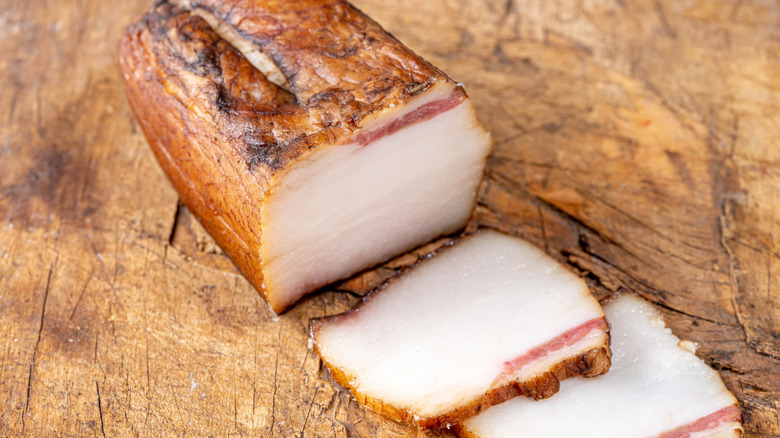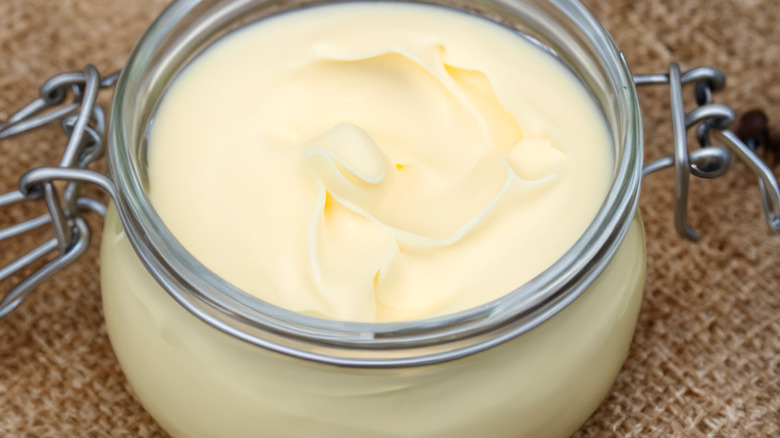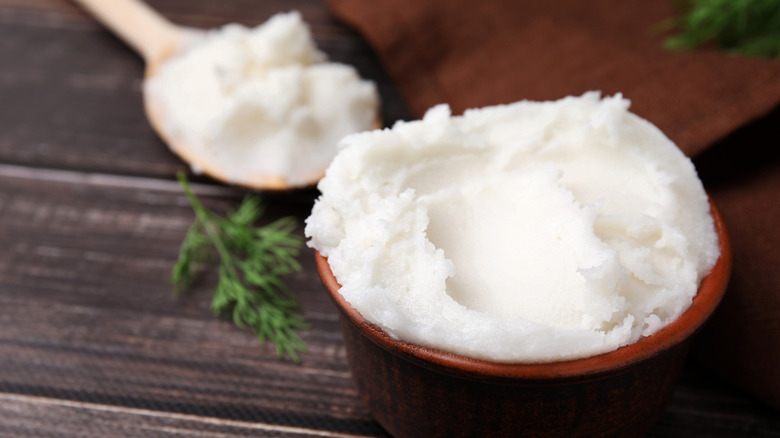Beef Tallow Vs Lard: What's The Difference?
It is often said that the four essential elements of cooking are salt, fat, acid, and heat. And while most people know their lemon juice from their red wine vinegar, or their crystal from their kosher salt, the type of fat we use when cooking at home often gets a little less consideration. Take, for example, two of the most popular animal fats — lard and beef tallow.
To many people, lard and tallow are interchangeable — indeed, it's true that the two share a lot of characteristics: They're both animal-derived cooking fats, renowned for their stability, relatively high smoke points, and versatility. But interchangeable they are not — and the likelihood is most people haven't considered that the differences between the two might actually be important when it comes to using them in your cooking.
Perhaps the most significant (and most commonly known) difference between the two is their source. Though they're both made by rendering the fat of an animal through a process of heating and straining (to separate it from meat and connective tissue), lard is made from pork, and beef tallow (no points for guessing this one) comes from beef. This one big difference, though, gives way to a whole host of other variations, not just in their provenance and production, but in their taste and texture, too.
The differences in taste between tallow and lard
While they may appear similar visually, one of the biggest differences between tallow and lard comes in how they taste, and subsequently affect the flavors of whatever dish you happen to be using them in. Beef tallow has a distinctly beefy flavor, rich, meaty, and fatty. As such, it's brilliant for cooking meat (or potatoes) in, as its savory, beefy overtones will bring a poignant depth of flavor, enhancing that often elusive fifth taste, umami. It's a wonderful fat to cook steak in, for example, producing a great crust while imparting extra flavor. It also has a nutty hint similar to that of brown butter, which can really aid in adding complexity to those more pared-back dishes that only use a handful of simple, good-quality ingredients.
Lard, meanwhile, has a much more neutral taste. As such, it doesn't impart any significant additional aromas to your food, making it a much better alternative to other cooking fats like vegetable or sunflower oil. Its neutrality makes it more versatile than tallow: It can be used in a huge range of dishes, from laminating pastries to greasing a griddle, ready to fry up some bacon and eggs. Lard also makes for a great substitute for bacon grease, by the way, though with a slightly more neutral flavor profile — think of bacon fat as an even closer cousin of beef tallow. Lard also has a subtle sweetness to it, which makes it a favorite among bakers.
The differences in how tallow and lard are used
Both beef tallow and lard are remarkably versatile in their uses when cooking. Tallow has a high smoke point — meaning that it can be heated to a super high temperature before it begins to smoke (when the flavor begins to break down as it starts to burn). This makes it an ideal choice for cooking dishes like steaks, which require a hard sear in a ripping hot pan.
Tallow's ability to hold up to high temperatures and (importantly) remain stable also makes it good for deep frying. It's not just for frying beef, either — in Britain, fish and chip shops traditionally fry battered fish in beef tallow (or dripping, as the Brits say.) It's especially useful when cooking potatoes because it adds a delicious savory flavor as well as extra crispiness to your next batch of roasted potatoes or french fries, and is equally adept at confiting. Plus, you can use any leftovers to make your own homemade soap, or to season your cast iron pan!
Lard, meanwhile, is okay for frying — but is even better when used for baking. It makes perfectly flaky crusts for sweet pastries like good ol' fashioned apple pies (to ensure that there's no trace of any pork flavor, make sure you buy processed lard). Plus, it can be used in more savory bakes, too, like the Latin American classic, enchiladas rojas (or verdes).



